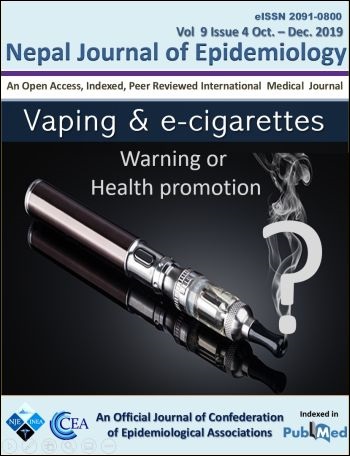Clinico-epidemiological profile of Acinetobacter and Pseudomonas infections, and their antibiotic resistant pattern in a tertiary care center, Western Nepal
DOI:
https://doi.org/10.3126/nje.v9i4.26962Keywords:
Acinetobacter spp, Pseudomonas aeruginosa, multi-drug resistance, antibiotic susceptibilityAbstract
Background: Infections caused by Acinetobacter species and Pseudomonas species, especially multidrug-resistant (MDR) strains pose a serious management challenge with a public health threat.
Materials and Methods: A hospital-based retrospective study of patients who were infected with Acinetobacter spp or Pseudomonas aeruginosa was carried out at Manipal Teaching Hospital from 2014 to 2016.
Results: A total of 170 cases of infections with Acinetobacter spp. and 313 cases with Pseudomonas aeruginosa were studied. The rate of nosocomial infections was higher than non-nosocomial infections. ICU was found as the major hub for both the organisms; (53.5% of cases due to Acinetobacter spp. and 39.6% due to Pseudomonas aeruginosa). Most isolates were of respiratory tract origin (Acinetobacter 74.7% and Pseudomonas aeruginosa 65.8%). Percentage resistance of Acinetobacter spp. towards polymyxin B was found to be quite low (18.8%). Similarly, resistance rates of Pseudomonas aeruginosa against amikacin were also found to be low, i.e., 17.4%. A higher prevalence of multidrug resistance was seen among Acinetobacter spp than among Pseudomonas aeruginosa (75.9% vs. 60.1%). The hospital stay was longer for patients infected with MDR isolate (p=0.001 for Acinetobacter spp. and p=0.003 for Pseudomonas aeruginosa). The mortality rate was higher in infections due to Acinetobacter spp (15.9%) as compared to Pseudomonas aeruginosa (8.3%).
Conclusion: These clinico-epidemiological data will help to implement better infection control strategies. Developing a local antibiogram database will improve the knowledge of antimicrobial resistance patterns in our region, facilitating the treating physician in advocating empiric therapy if need be.
Downloads
Downloads
Published
How to Cite
Issue
Section
License
- Upon acceptance Copyright on any research article is transferred in full to the Confederation of Epidemiological Associations (CEA) and International Nepal Epidemiological Association (INEA). The copyright transfer includes the right to reproduce and distribute the article in any form of reproduction (printing, electronic media or any other form).
- Articles in the Nepal Journal of Epidemiology are Open Access articles published under the Creative Commons CC BY License (https://creativecommons.org/licenses/by/4.0/)
- This license permits use, distribution and reproduction in any medium, provided the original work is properly cited.




